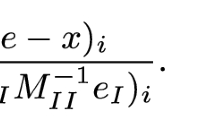Abstract
This paper proposes an interior point algorithm for a positive semi-definite linear complementarity problem: find an (x, y)∈ℝ2n such thaty=Mx+q, (x,y)⩾0 andx T y=0. The algorithm reduces the potential function
by at least 0.2 in each iteration requiring O(n 3) arithmetic operations. If it starts from an interior feasible solution with the potential function value bounded by\(O(\sqrt n L)\), it generates, in at most\(O(\sqrt n L)\) iterations, an approximate solution with the potential function value\( - O(\sqrt n L)\), from which we can compute an exact solution in O(n 3) arithmetic operations. The algorithm is closely related with the central path following algorithm recently given by the authors. We also suggest a unified model for both potential reduction and path following algorithms for positive semi-definite linear complementarity problems.
Similar content being viewed by others
References
I. Adler, N. Karmarkar, M.G.C. Resende and G. Veiga, “An implementation of Karmarkar's algorithm for linear programming,”Mathematical Programming 44 (1989) 297–335.
K.M. Anstreicher and R.A. Bosch, “Long steps in a O(n 3 L) algorithm for linear programming,” Technical Report, Yale School of Management (New Haven, CT, 1989).
E.R. Barnes, “A variation on Karmarkar's algorithm for solving linear programming problems,”Mathematical Programming 36 (1986) 174–182.
I.I. Dikin, “Iterative solution of problems of linear and quadratic programming,”Soviet Mathematics Doklady 8 (1967) 674–675.
R.M. Freund, “Polynomial-time algorithms for linear programming based only on primal scaling and projected gradients of a potential function,” OR 182-88, Sloan School of Management, Massachusetts Institute of Technology (Cambridge, MA, 1988).
D Gay, “A variant of Karmarkar's linear programming algorithm for problems in standard form,”Mathematical Programming 37 (1987) 81–90.
C.C. Gonzaga, “Newton barrier function algorithms for following the cental trajectory in linear programming problems,”13th Mathematical Programming Symposium, Tokyo, Department of Systems Engineering and Computer Sciences, COPPE-Federal University of Rio de Janeiro (Rio de Janeiro, Brasil, 1988).
C.C. Gonzaga, “An algorithm for solving linear programming programs in O(n 3 L) operations,” in: N. Megiddo, ed.,Progress in Mathematical Programming, Interior-Point and Related Methods (Springer, New York, 1989) pp. 1–28.
N. Karmarkar, “A new polynomial-time algorithm for linear programming,”Combinatorica 4 (1984) 373–395.
M. Kojima, N. Megiddo and T. Noma, “Homotopy continuation methods for nonlinear complementarity problems,” to appear in:Mathematics of Operations Research (1991).
M. Kojima, N. Megiddo and Y. Ye, “An interior point potential reduction algorithm for the linear complementarity problem,” to appear in:Mathematical Programming (1992).
M. Kojima, S. Mizuno and A. Yoshise, “A primal—dual interior point algorithm for linear programming,” in: N. Megiddo, ed.,Progress in Mathematical Programming, Interior-Point and Related Methods (Springer, New York, 1989) pp. 29–47.
M. Kojima, S. Mizuno and A. Yoshise, “A polynomial-time algorithm for a class of linear complementary problems,”Mathematical Programming 44 (1989) 1–26.
N. Megiddo, “Pathways to the optimal set in linear programming,” in: N. Megiddo, ed.,Progress in Mathematical Programming, Interior-Point and Related Methods (Springer, New York, 1989) pp. 131–158.
R.D.C. Monteiro and I. Adler, “Interior path following primal—dual algorithms. Part I: Linear programming,”Mathematical Programming 44 (1989) 27–41.
R.D.C. Monteiro and I. Adler, “Interior path following primal—dual algorithms. Part II: Convex quadratic programming,”Mathematical Programming 44 (1989) 43–66.
J. Renegar, “A polynomial-time algorithm based on Newton's method for linear programming,”Mathematical Programming 40 (1988) 59–94.
G. Sonnevend and J. Stoer, “Global ellipsoidal approximations and homotopy methods for solving convex analytic programs,” Report No. 40, Institut für Angewandte Mathematik und Statistik, Universität Würzburg (Am Hubland, Würzburg, 1988).
M.J. Todd and B.P. Burrell, “An extension of Karmarkar's algorithm for linear programming and using dual variables,”Algorithmica 1 (1986) 409–424.
M.J. Todd and Y. Ye, “A centered projective algorithm for linear programming,”Mathematics of Operations Research 15 (1990) 508–529.
P.M. Vaidya, “An algorithm for linear programming which requires O(((m+n)n 2+(m+n) 1.5 n)L) arithmetic operations,”Mathematical Programming 47 (1990) 175–201.
Y. Ye, “A class of potential functions for linear programming,” Technical Report, Department of Management Sciences, The University of Iowa (Iowa City, IA, 1988).
Y. Ye and M. Kojima, “Recovering optimal dual solutions in Karmarkar's polynomial algorithm for linear programming,”Mathematical Programming 39 (1987) 305–317.
Author information
Authors and Affiliations
Additional information
Supported by Grant-in-Aids for Co-operative Research (63490010) of The Ministry of Education, Science and Culture.
Supported by Grant-in-Aids for Young Scientists (6370014) and Co-operative Research (63490010) of The Ministry of Education, Science and Culture.
Rights and permissions
About this article
Cite this article
Kojima, M., Mizuno, S. & Yoshise, A. An\(O(\sqrt n L)\) iteration potential reduction algorithm for linear complementarity problems. Mathematical Programming 50, 331–342 (1991). https://doi.org/10.1007/BF01594942
Received:
Revised:
Issue Date:
DOI: https://doi.org/10.1007/BF01594942




